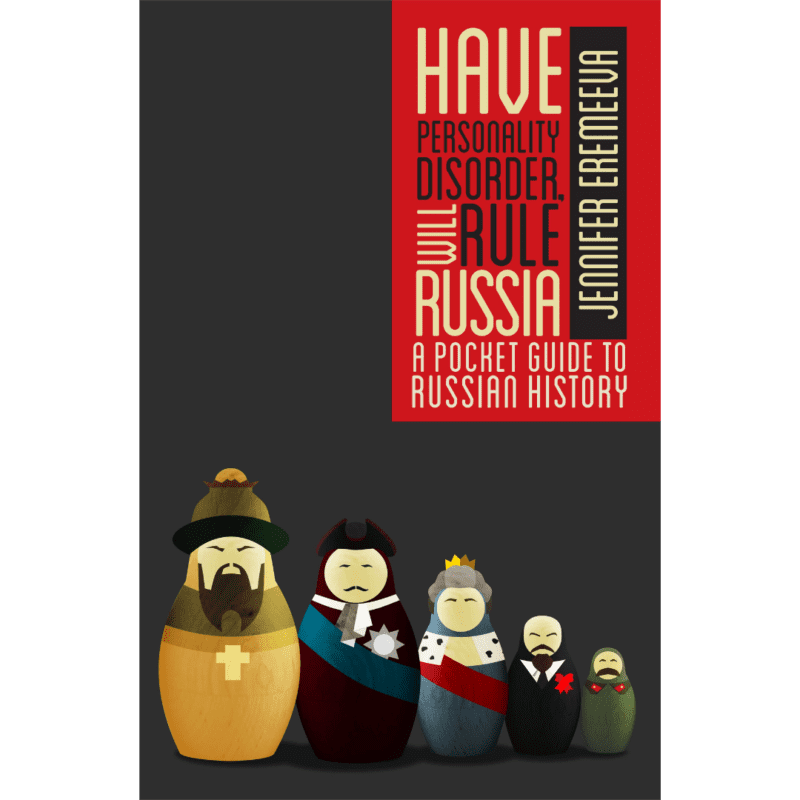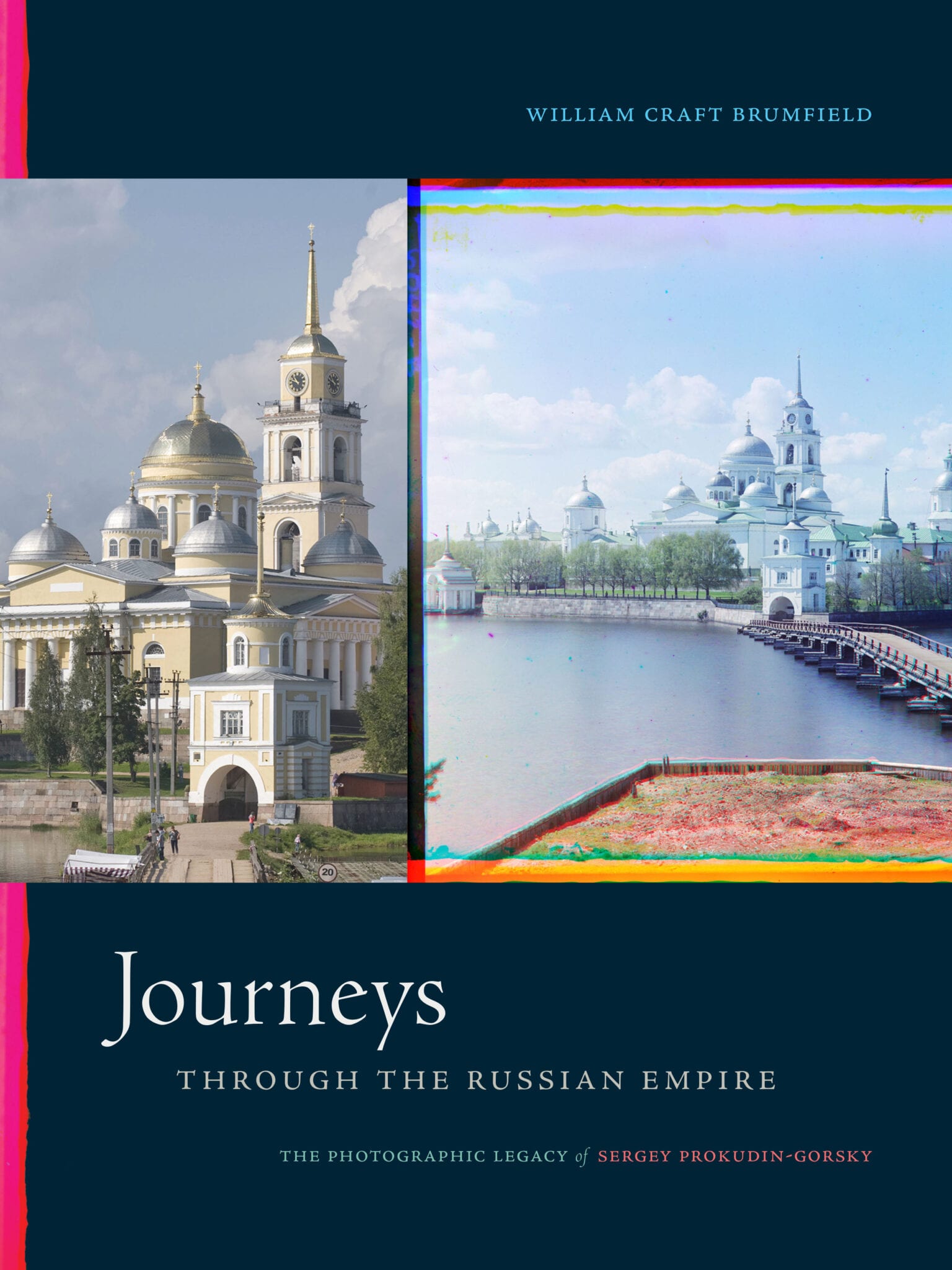
A Podcast for the New Books Network
Journeys through the Russian Empire
The Photographic Legacy of Sergey Prokudin-Gorsky
William Craft Brumfield
Duke University Press, 2020
A Journey in Space and Time
Photography, since its inception, has provided an invaluable window into Russia’s turbulent past. The revolutions of 1917 irrevocably altered the course of Russia’s history with seismic political change, but also rendered an entire way of life not only obsolete but also taboo. Historians are left to pour over sepia-toned photos to piece together the vanished and vanquished world of Imperial Russia.
How fortunate we are, therefore, that much of the pioneering color photography of Sergey Prokudin-Gorsky (1863-1944), who documented the Russian Empire in its waning decades, has survived for posterity. In his latest authoritative book, “Journeys Through the Russian Empire: The Photographic Legacy of Sergey Prokudin-Gorsky,” (Duke University Press, 2020) Russian scholar, photographer, and chronicler of Russian architecture William Craft Brumfield frames the life and work of Prokudin-Gorsky while also putting his own magisterial career into sharp perspective as he updates and interprets several of Prokudin-Gorsky’s iconic images with his own late twentieth and early twenty-first century versions. The result is an extraordinary study of two photographers and, indeed, two Russias.
Photography, since its inception, has provided an invaluable window into Russia’s turbulent past. The revolutions of 1917 irrevocably altered the course of Russia’s history with seismic political change, but also rendered an entire way of life not only obsolete but also taboo. Historians are left to pour over sepia-toned photos to piece together the vanished and vanquished world of Imperial Russia. How fortunate we are, therefore, that much of the pioneering color photography of Sergey Prokudin-Gorsky (1863-1944), who documented the Russian Empire in its waning decades, has survived for posterity. In his latest authoritative book, “Journeys Through the Russian Empire,” (Duke University Press, 2020) Russian scholar, photographer, and chronicler of Russian architecture William Craft Brumfield frames the life and work of Prokudin-Gorsky while also putting his own magisterial career into sharp perspective as he updates and interprets several of Prokudin-Gorsky’s iconic images with his own late twentieth and early twenty-first century versions. The result is an extraordinary study of two photographers and, indeed, two Russias.
A Polymath and Entrepeneur
Prokudin-Gorsky was a creature of his expansive and creative era. This polymath, inventor, explorer, entrepreneur, and eminently talented photographer was a scion of Russia’s provincial nobility. He received an excellent education in St. Petersburg that focused on both science and the arts, perfectly positioning him to pursue his passion for the emerging technology of photography. Prokudin-Gorsky felt strongly that photography demanded a full understanding of the science behind the technology, but he also understood its inevitable march towards main-stream use by amateurs; his ability to make peace with these competing notions was one of his greatest strengths, and a strong entrepreneurial streak enabled him to harness the economic potential of the emerging phenomenon in a ground-breaking career.
Prokudin-Gorsky studied in St. Petersburg, graduating in 1889 from the faculty of Natural Sciences, after which he traveled to both Berlin and Paris to work with leading chemists and photographers. From the beginning of his professional life, he pursued his goal to produce color photography, but throughout his career, he was a vocal champion for his colleagues, assuming the editorship of Russia’s “Amateur Photography,” and campaigning successfully for photographers to assert ownership of their work.
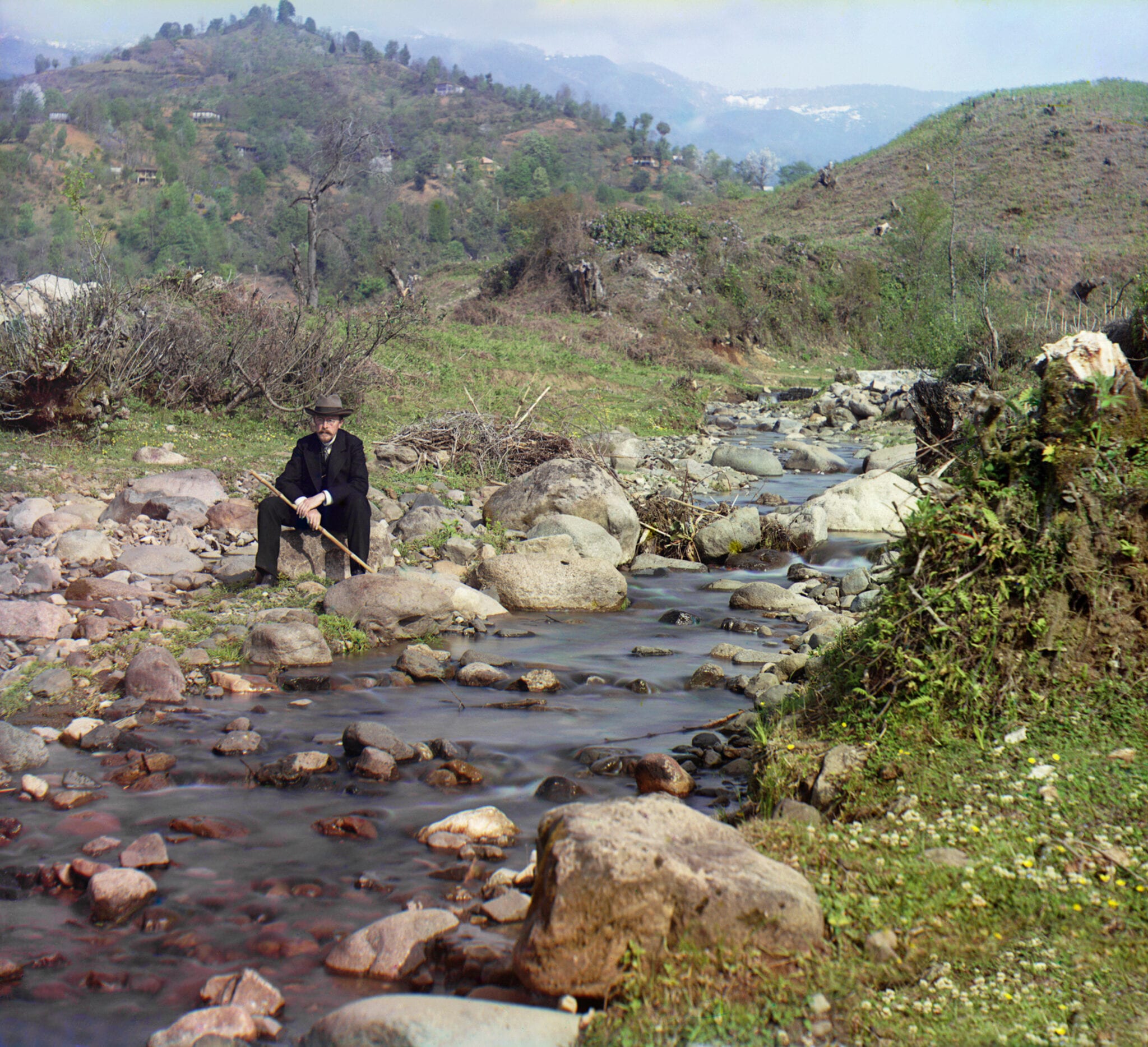
A self portrait of Sergey Prokudin-Gorsky. Via Wikimedia Commons
Imperial Patronage
The scope of Prokudin-Gorsky’s ambitions matched the size of the Russian empire he sought to capture and preserve with his new color technology: a daunting one fifth of the world’s land mass with a Byzantine Imperial bureaucracy that hindered access to many of the empire’s more picturesque corners and objects. Fortunately for Prokudin-Gorsky, in 1909 his work came to the attention of the Imperial Family — passionate shutterbugs themselves — and after successful presentations of his color slides to the tsar’s brother, Grand Duke Michael and his mother, Dowager Empress Maria Feodorovna, Prokudin-Gorsky secured an invitation to present them to Nicholas II and his family.
Contemporary sources characterize Nicholas II as a great waffler, but in the matter of Prokudin-Gorsky’s request for Imperial patronage of an ambitious plan to photograph the Russian empire, the sovereign remained steadfast. Nicholas II ordered the Minister of Ways and Communications to furnish Prokudin-Gorsky with a specially designed Pullman railway car for his laboratory, and access to river transport. The tsar also gave Prokudin-Gorsky an enviable laissez-passer for the entire empire, and an order that enabled the photographer to solicit aid from all government officials. For the next six years, Prokudin-Gorsky traveled throughout the empire on several regional expeditions, using his color method to document the Ministry’s development projects, particularly the rapidly expanding railroad network that was fast-forwarding Russia into a powerful industrial nation. But along the way, he also captured the natural beauty of Russia’s wilder corners: the majestic Caucasus, the arid desert of Central Asia, and the dense forests of the Urals.
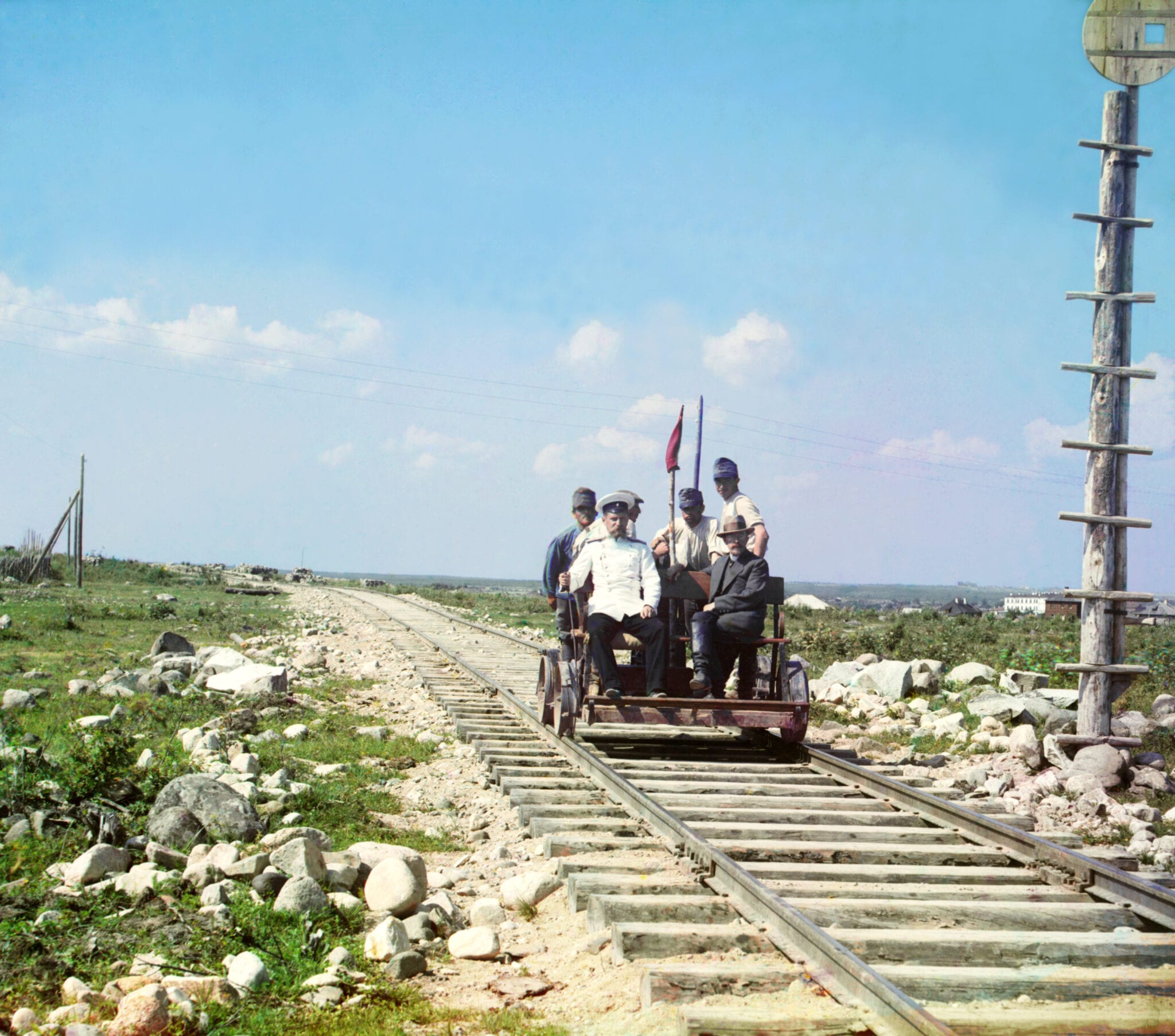
Prokudin-Gorsky outside Petrozavodsk on the Murmansk railway, 1915. Via Wikimedia Commons
Want to Refresh your Podcast Feed?
Download 12 New Podcasts for 2021: my go-to shows for news, culture, and lifestyle hacks!
Documenting Empire
Prokudin-Gorsky’s innovative color technology involved photographing a subject with three separate plates, and by necessity, his subjects had to be stationary, or at least be willing and able to stand very still. But the resulting images are anything but static; Prokudin-Gorsky’s art studies pay off in the masterful framing and use of perspective in photographs that pulse with life and color.
It is unlikely that Prokudin-Gorsky understood that he was documenting a world that would soon disappear. But disappear it did. In 1918, Prokudin-Gorsky fled Russia, bringing with him thousands of color slides, which he had tried to get the Stolypin government to purchase in 1910, but they had, as Brumfield notes, “with myopic parsimoniousness… let the matter die.” After Prokudin-Gorsky’s death in 1944, the Library of Congress acquired the collection of his negatives.
Fast forward half a century, and another photographer and chronicler of Russia’s rich architectural traditions began to document many of the same locations that first drew Prokudin-Gorsky. William Craft Brumfield is the foremost Western expert on Russian architecture and taught at some of the world’s most renowned centers of Slavic studies, including Harvard, Tulane, and the Pushkin Institute. In 2019, in recognition of Brumfield’s contribution to Russian culture, President Putin awarded him with Russia’s highest honor for a foreigner: The Order of Friendship.
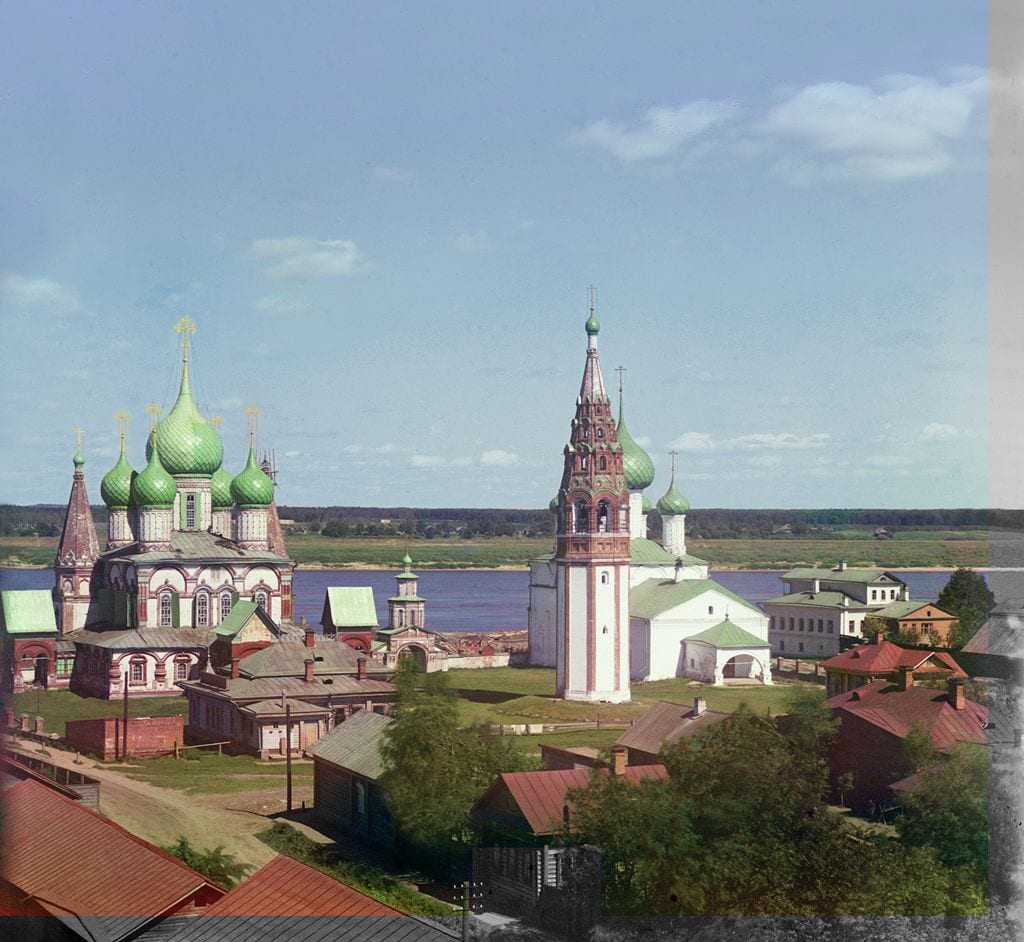
View of the Church of St. John Chrysostom and architectural ensemble in Korovniki, Yaroslavl, 1911. Via Wikimedia Commons
A Tale of Two Photographers
Fast forward half a century, and another photographer and chronicler of Russia’s rich architectural traditions began to document many of the same locations that first drew Prokudin-Gorsky. William Craft Brumfield is the foremost Western expert on Russian architecture and taught at some of the world’s most renowned centers of Slavic studies, including Harvard, Tulane, and the Pushkin Institute. In 2019, in recognition of Brumfield’s contribution to Russian culture, President Putin awarded him with Russia’s highest honor for a foreigner: The Order of Friendship.
Brumfield is an academic who thrives in the field — his outstanding photography of Russia’s architecture is an invaluable resource to students of Russian art and architecture, and the country’s history. He was a natural choice to curate a public exhibition of Prokudin-Gorsky’s collection for the Library of Congress in 1986 and his association with the Library and the collection has continued to this day, with “Journeys Through the Russian Empire” as a magnificent culmination of this fruitful collaboration.
It is unlikely that Prokudin-Gorsky understood that he was documenting a world that would soon disappear. But disappear it did. In 1918, Prokudin-Gorsky fled Russia, bringing with him thousands of color slides, which he had tried to get the Stolypin government to purchase in 1910, but they had, as Brumfield notes, “with myopic parsimoniousness… let the matter die.” After Prokudin-Gorsky’s death in 1944, the Library of Congress acquired the collection of his negatives.
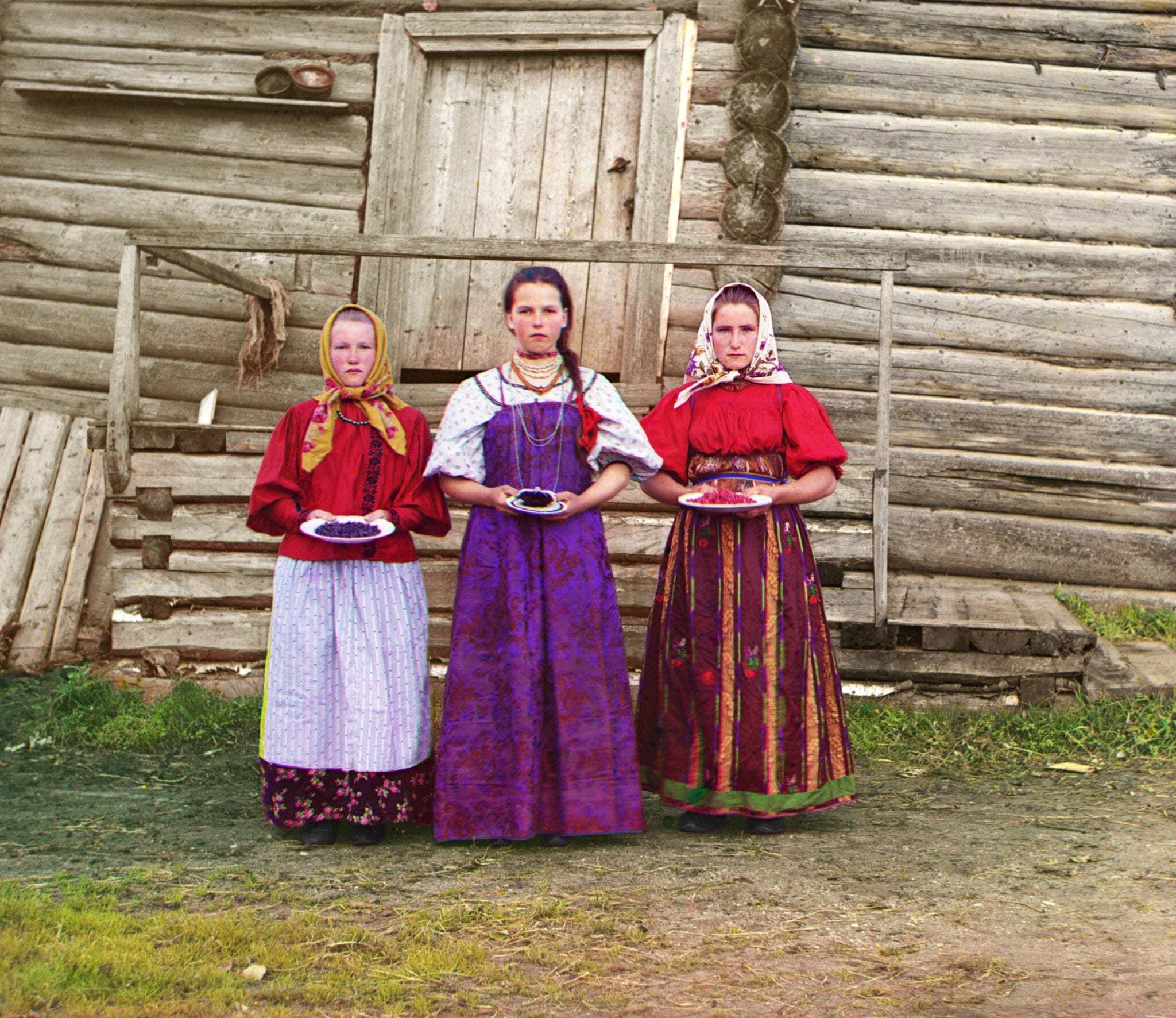
Young Russian peasant women in front of traditional wooden house, in a rural area along the Sheksna River near the small town of Kirillov. Via Wikimedia Commons.
Evocative Pairings
“Journeys Through the Russian Empire” presents a selection of photographs from eight of Prokudin-Gorsky’s expeditions throughout the Russian Empire, from 1909 to 1915. Brumfield has cleverly arranged these, not chronologically but in a logarithmic spiral like that of a Nautilus shell, beginning with the oldest Russian principalities such as Suzdal in the center and expanding ever outwards to the Volga river lands, the Ural Mountains, Siberia, Central Asia, and culminating a trip to the remote Solovetsky Islands, which in Prokudin-Gorsky’s day was a monastery and in Brumfield’s, a decommissioned GULAG prison camp. Each chapter showcases selections of Prokudin-Gorsky’s work and Brumfield’s own interpretation of the same object, often from the same vantage. Occasionally, the shots are so uncannily similar that one has to refer to the notes to ascertain which image predates the other. But in other evocative pairings we cannot help but note the effects not only of time but also politics and economics. Brumfield shows us churches that have repurposed or simply allowed to decay, but he also shows us more recent attempts to restore and revitalize. While Prokudin-Gorsky’s photos were taken over only six years, Brumfield’s span almost three decades, and in this progression, we see the changes in Russia from perestroika to the present.
Anyone who has traveled throughout Russia’s vast regions recalls the staggering beauty of nature and the magnificence of the architecture, particularly in the more remote corners of the country. Both Prokudin-Gorsky and Brumfield capture this richness with images that are so immediate and evocative that one almost feels the heat of the sun radiating off the stone walls of Registan Square in Samarkand or catches sound of the Volga River lapping against the shore of tiny jewel-like Uglich or detects the musty odor of a long-neglected church. “Journeys Through the Russian Empire” deliberately eschews photos of either Moscow or St. Petersburg, allowing the quiet majesty of Russia’s often overlooked provinces to take center stage. This is an excellent decision by Brumfield, reflecting and honoring Prokudin-Gorsky’s desire to capture the breadth of Russia for the empire’s citizens.
“Journeys Through the Russian Empire” is a masterful achievement that readers of all nationalities and interests will want to savor and return to again and again. In its pages are insightful lessons on everything from color photography to the nature of time. William Craft Brumfield has brought all of his considerable talent, expertise, and energy to produce an invaluable resource for students of Russian history, photography buffs, nature lovers, architecture aficionados, and anyone who longs to explore the expansive Russian empire through the eyes of two eminently talented and devoted photographers.
Enjoy my conversation with William Craft Brumfield
William Craft Brumfield is the foremost Western expert on Russian architecture, and taught at some world’s most renowned centers of Slavic studies, including Harvard, Tulane, and the Pushkin Institute. In 2019, in recognition of Brumfield’s contribution to Russian culture, President Putin awarded him with Russia’s highest honor for a foreigner: The Order of Friendship.

Alim Khan (1880-1944), Emir of Bukhara, taken in 1911. Via Wikimedia Commons
Thank you for stopping by!
Let’s stay connected!
Thank you for stopping by for this podcast! If you’d like to learn more about The New Books Network, visit their website and subscribe to any of the 87 channels, covering almost every academic discipline. I contribute to the Food, Russia & Eurasia Studies, European Studies, Eastern European Studies, and Historical Fiction channels.
This text was originally part of a Moscow Times long reads article. The original can be found here with an excerpt from Journeys Through the Russian Empire.
Below, you’ll find more information on the kind of subjects I write about — it’s an eclectic list! I’ve also included links to previous posts about travel, cuisine, history, and lifestyle topics. I hope you’ll enjoy browsing around.
This post does contain affiliate links. Any purchases you choose to make via these links will net me a small commission from the retailer. I use these funds to support the maintenance and development of this website.
I hope you’ll consider staying connected with me by subscribing to receive regular updates or joining the conversation on Facebook, Twitter, Instagram, and Pinterest!
Images in this post are sourced from Shutterstock by artists Natalia Volkova, Brass Monkey, and Igor Zuikov
Food
Exploring food markets, developing recipes, and just eating was once my hobby, but now it is a full-time job. I write about food markets around the world, develop recipes, and study culinary history and emerging trends. I have a particular interest in Russian and Eastern European cuisine and culinary history.
Lifestyle
I believe that great books are part of a life well lived and this extends to audio entertainment. Under the Lifestyle umbrella, I review books, podcasts, and audiobooks, I discuss writing and reading and am constantly on the lookout for new ways to be productive and clear all manner of clutter from my life.
Enjoy more discussions and reviews like this one
Pin this!

Pin this!

Pin this!




